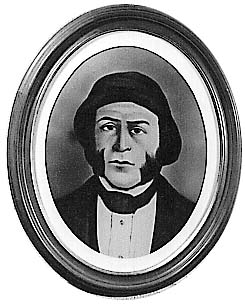Juan María Marrón on:
[Wikipedia]
[Google]
[Amazon]
 Juan María Marrón (February 8, 1808 – September 17, 1853) was an early settler of San Diego, California.
Juan María Marrón (February 8, 1808 – September 17, 1853) was an early settler of San Diego, California.
Historia Baja, Chapter 18, p.11
from consag.tij.uia.mx/ebooks/historia_baja accessed May 31, 2014 Marrón was granted
"Rancho Agua Hedionda", (Carlsbad, California)
* 1850 Census, San Diego, California, p. 278B
 Juan María Marrón (February 8, 1808 – September 17, 1853) was an early settler of San Diego, California.
Juan María Marrón (February 8, 1808 – September 17, 1853) was an early settler of San Diego, California.
Life
Marrón was a ship's captain before settling San Diego in the early 1820s. In 1834 Marrón, married Felipa Osuna (c. 1818 – December 21, 1871), the daughter ofJuan María Osuna
Juan María Osuna (1785 – March 5, 1851) was an early settler of San Diego, California.
Life
Juan María Osuna was born 1785 in California to Juan Hismerio Osuna and Maria Alvarado. He was a soldier and corporal of the San Diego Company and ...
. They had three sons and one daughter.
Marrón served as the first Alcade
Alcalde (; ) is the traditional Spanish municipal magistrate, who had both judicial and administrative functions. An ''alcalde'' was, in the absence of a corregidor, the presiding officer of the Castilian '' cabildo'' (the municipal council) a ...
of the Pueblo of San Diego during 1 January 1835–1836. He also served as Regidor (Alderman) and Juez de Paz (Justice of the Peace). He is known to have owned the Rancho Cueros de Venado
Rancho Cueros de Venado ("Hides of Deer") was an 1835 land grant in the vicinity of the Pueblo of San Diego of Alta California, and whose site is in present-day Tijuana in Baja California, Mexico.
An ''expediente'' was submitted on August 29, 183 ...
, located southeast of what is now Tijuana
Tijuana ( ,"Tijuana"
(US) and < ...
, from sometime before 1836. Like many of the local ranchos near San Diego, that rancho was attacked by the (US) and < ...
Kumeyaay
The Kumeyaay, also known as Tipai-Ipai or by their historical Spanish name Diegueño, is a tribe of Indigenous peoples of the Americas who live at the northern border of Baja California in Mexico and the southern border of California in the Unit ...
during the hostilities between 1836 and 1840.from consag.tij.uia.mx/ebooks/historia_baja accessed May 31, 2014 Marrón was granted
Rancho Agua Hedionda
Rancho Agua Hedionda was a Mexican land grant in present-day San Diego County, California given in 1842 by Governor Juan Alvarado to Juan María Marrón. The name means "stinking water" in Spanish. The grant extended south along the Pacific C ...
in 1842, which is in the southern coastal part of present-day Carlsbad. Agua Hedionda means "stinking water", named after decayed organic material in the Agua Hedionda Lagoon
The Agua Hedionda Lagoon ("agua hedionda" means "fetid water" in Spanish) is a lagoon in Carlsbad, California, that is fed by the Agua Hedionda Creek. Stewardship of much of the lagoon is held by the Encina Power Station and its owner NRG En ...
.
During the Mexican–American War
The Mexican–American War, also known in the United States as the Mexican War and in Mexico as the (''United States intervention in Mexico''), was an armed conflict between the United States and Mexico from 1846 to 1848. It followed the 1 ...
Marrón supported the Americans. This caused him hardship and embarrassment with his friends. Once incident was related by Richard F. Pourade in ''The Silver Dons'':
:One morning, along the road from the mission, came ''Alcalde'' Juan María Marrón, husband of Felipa Osuna, carrying a white flag. He wanted to visit his wife. Capt. Miguel de Pedrorena took him into custody, but Commodore Robert F. Stockton
Robert Field Stockton (August 20, 1795 – October 7, 1866) was a United States Navy commodore, notable in the capture of California during the Mexican–American War. He was a naval innovator and an early advocate for a propeller-driven, steam-p ...
finally gave Felipa and her husband a pass through the lines, to go to their rancho. With their children they walked all the way to San Luis Rey Mission, where another band of Californios
Californio (plural Californios) is a term used to designate a Hispanic Californians, Hispanic Californian, especially those descended from Spanish and Mexican settlers of the 17th through 19th centuries. California's Spanish language, Spanish-s ...
seized them and threatened to shoot Marrón for having collaborated with the Americans. They released him but stripped his Agua Hedionda Rancho of horses and cattle.
Later Rancho Agua Hedionda was acquired and held by the Kelly family for many years. The adobe home of Marrón still stands, although modernized in the 1960s.
Marrón died in 1853 and is buried in El Campo Santo Catholic Cemetery in Old Town San Diego.
Sources
* "Agua Hedionda Rancho", ''Historic Ranchos of San Diego'' by Cecil C. Moyer, Richard F. Pourade, ed. (1960)"Rancho Agua Hedionda", (Carlsbad, California)
* 1850 Census, San Diego, California, p. 278B
References
People from San Diego 1808 births 1853 deaths People of Mexican California People of Alta California {{California-stub